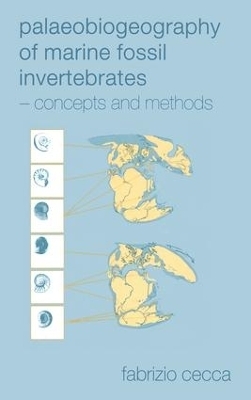
Palaeobiogeography of Marine Fossil Invertebrates
CRC Press (Verlag)
978-0-415-28789-0 (ISBN)
- Titel z.Zt. nicht lieferbar
- Versandkostenfrei
- Auch auf Rechnung
- Artikel merken
Sitting squarely at the interface between earth and life sciences, palaeobiogeographic information is scattered throughout many publications. Until now. Palaeobiogeography of Marine Fossil Invertebrates covers important theoretical concepts relating to palaeobiogeography together with descriptions of analytical methods.
Fabrizio Cecca discusses general biogeographical concepts and the factors influencing distributional patterns and provides case histories that illustrate the concepts covered. Cecca uses the palaeobiogeography of fossil organisms to generate hypotheses on continental drifting, past migration routes, palaeobiodiversity gradients, geographic barriers, palaeoclimatic and paleooceanographic conditions. He explores the biogeographical dimension of biodiversity through the analysis of existing latitudinal and longitudinal gradients of biodiversity and discusses the biodiversity/area relationship with particular reference to sea-level variations.
Much of the material in the book has been drawn from the author's personal research and experience in ammonites and the Mesozoic pelagic biotas. To avoid lack of balance, he includes carefully selected case histories based on other fossil groups and geologic periods. The book is primarily for students and researchers of geology and palaeontology who whish to gain an understanding of palaeobiogeography, but will also be of interest to marine biologists concerned with the biogeographic aspects of palaeontology and evolution.
Fabrizio Cecca
INTRODUCTION. Processes of Speciation and Biogeography. Biogeography: Neo-and Palaeobiography. The Aims of Palaeobiography. The Different Biogeographies. GENERAL BIOGEOGRAPHICAL CONCEPTS. The Main Distributional Patterns. The Three Main Categories of Biogeographical Processes. CLASSICAL THEORETICAL MODELS: DISPERSAL AND VARIANCE. Barriers and Filters. The Dispersal Model and the "Centre of Origin". Panbiogeography. The Variance Model. Centres of Origin in Palaeobiogeography. BIOGEOGRAPHIC ANALYSES AND BIOGEOGRAPHICAL CLASSIFICATION. Rationales. Limits and Constraints of Paleobiogeography. Definition of Biogeographic Units: Qualitative Criteria. Quantitative Criteria (Phenetics). Are Biotic Provinces Objective? ANALYTICAL METHODS OF HISTORICAL PALAEOBIOGEOGRAPHY. The Method of Cladistics Biogeography. Brook's Parsimony Analysis (BPA). Parsimony Analysis of Endemicity (PAE). Retrovicariance Biogeography. LARVAL BIOGEOGRAPHY. Types of Larval Development. Larval Development in Some Groups of Marine Invertebrates. Rates of Dispersion. Palaeocurrents. Larval Development and Evolutionary Implications. PALAEOBIODIVERSITY AND PALAEOBIOGEOGRAPHY. Biodiversity in Palaeontology. Communities and Guilds. Biogeographical Patterns of Biodiversity. Equilibrium Theory and Species-Area Relationships. Are Extinctions Related to Sea-Level Falls? The Biogeography of Mass Extinctions. Disturbance Events and Deviations from Specie-Area Predictions. PALAEOGEOGRAPHY AND PALAEOGEOGRAPHIC RECONSTRUCTIONS. Geological Assemblages. Marine Corridors and Routes. The Problem of the Terranes. Longitudinal Patterns: Newton's Model of Pantropical Faunas. Index.
| Erscheint lt. Verlag | 12.9.2002 |
|---|---|
| Zusatzinfo | 6 Tables, black and white |
| Verlagsort | London |
| Sprache | englisch |
| Maße | 138 x 216 mm |
| Gewicht | 690 g |
| Themenwelt | Naturwissenschaften ► Geowissenschaften ► Geografie / Kartografie |
| Naturwissenschaften ► Geowissenschaften ► Mineralogie / Paläontologie | |
| ISBN-10 | 0-415-28789-8 / 0415287898 |
| ISBN-13 | 978-0-415-28789-0 / 9780415287890 |
| Zustand | Neuware |
| Haben Sie eine Frage zum Produkt? |
aus dem Bereich


